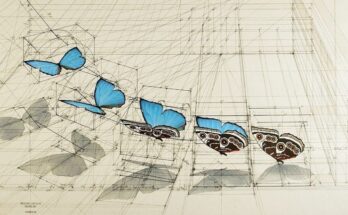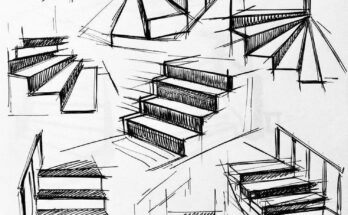Mastering Perspective Drawing: A Step-by-Step Guide to 1-Point, 2-Point, and 3-Point Systems for Stunning 3D Illusions

Unlock the power of perspective to transform your 2D sketches into convincing 3D scenes with this comprehensive, beginner-friendly tutorial. Designed for artists of all levels—whether you’re sketching corridors, buildings, or dynamic character poses—this guide breaks down the essentials of 1-point, 2-point, and 3-point perspective using clear diagrams and actionable steps.
Learn how to harness vanishing points, horizon lines, and guidelines to create depth and proportion, avoiding common pitfalls like distortion or flatness. The annotated illustrations above provide a visual roadmap, making it easy to apply these techniques to any drawing project. Perfect for illustrators, architects, and comic creators looking to elevate their craft.
Core Principles of Perspective Drawing
- Horizon Line: Determines the eye level, acting as the anchor for vanishing points.
- Vanishing Points (VPs): Points where parallel lines converge, creating the illusion of depth.
- Guidelines: Lines drawn from edges to VPs, ensuring proportional accuracy.
- Key Rule: All vertical lines remain parallel unless specified otherwise in 3-point perspective.
Step-by-Step Perspective Systems
1. One-Point Perspective (Ideal for Corridors and Front Views)
- Setup:
- Single VP placed on the horizon line (eye level).
- All lines parallel to the X-axis converge to this point.
- Application:
- Perfect for drawing rooms, roads, or faces straight-on.
- Example: A rectangular room where side walls taper toward the VP.
- How to Draw:
- Draw a horizon line.
- Place one VP at the center.
- Draw a square or rectangle, then extend guidelines from its edges to the VP.
- Pro Tip: Keep the VP within the canvas for simplicity; it’s “pretty much all it’s good for.”
2. Two-Point Perspective (Versatile for Corner Scenes)
- Setup:
- Two VPs on the horizon line, typically 90° apart (or adjusted for a 45° split).
- Vertical lines remain parallel; horizontal lines converge to the VPs.
- Application:
- Ideal for buildings, boxes, or objects viewed from a corner.
- Example: A house with one wall facing forward and another receding.
- How to Draw:
- Draw a horizon line with two VPs.
- Sketch a vertical line for the front edge.
- Extend guidelines from the top and bottom of this line to both VPs.
- Caution: Avoid placing VPs too close—distortion occurs if the field of vision exceeds 60°.
- Pro Tip: Adjust VP distance to control depth; wider spacing reduces distortion.
3. Three-Point Perspective (Dynamic High/Low Angles)
- Setup:
- Two VPs on the horizon line, plus a third VP above or below (usually outside the canvas).
- All lines, including verticals, converge to a VP.
- Application:
- Great for dramatic views (e.g., skyscrapers from below or birds-eye cityscapes).
- Example: A tall building where vertical lines taper upward.
- How to Draw:
- Draw a horizon line with two VPs.
- Add a third VP above or below, farther from the canvas.
- Draw a vertical line, then extend guidelines to all three VPs.
- Pro Tip: Place the third VP outside the canvas to avoid overcrowding and maintain natural proportions.
Practical Workflow
- Determine Eye Level: Set the horizon line based on the viewer’s height (e.g., 5–6 feet for standing).
- Place Vanishing Points: One for 1-point, two for 2-point, three for 3-point.
- Draw Guidelines: Extend lines from object edges to VPs.
- Check Proportions: Ensure objects appear smaller as they recede.
- Refine: Add details, keeping verticals parallel unless using 3-point.
Time Estimate: 5–15 minutes per sketch, depending on complexity.
Pro Tips for Success
- Blue Lines Illusion: Treat non-parallel lines as part of the depth illusion—don’t make them truly parallel.
- Object Proportions: Draw objects farther from the VP smaller, maintaining relation to the vanishing point.
- Field of Vision: Limit 2-point to a 60° view; wider angles require 3-point or adjustment.
- Vertical Control: In 3-point, the third VP adds vertical convergence—use it sparingly for dramatic effect.
Common Mistakes & Fixes
| Mistake | Cause | Fix |
|---|---|---|
| Flat look | No VPs | Add at least 1 VP |
| Distorted shapes | VPs too close | Space VPs wider apart |
| Uneven verticals | Ignoring 3-point | Add third VP above/below |
| Overcrowded canvas | VPs inside frame | Move VPs outside |
Tools & Materials
- Pencils: HB (guidelines), 2B (outlines), 4B (shading)
- Paper: Graph paper or sketchbook
- Ruler: For precise horizon and VP placement
- Optional: Digital tools (e.g., Procreate, Photoshop) with perspective grids
Downloadable Resources
- PDF Guide: Printable templates for 1-point, 2-point, and 3-point perspectives
- PSD File: Layered examples for digital practice
- Video Tutorial: 10-minute walkthrough (coming soon)
- Reference Pack: 15 scene sketches with VPs marked
Ideal For:
- Beginner artists learning basics
- Illustrators and comic creators
- Architecture and interior sketchers
- Digital artists exploring 3D effects
- Students mastering drawing fundamentals
Draw with Depth and Confidence. Master the art of perspective with this step-by-step system, turning flat sketches into dynamic 3D masterpieces. Whether it’s a simple corridor or a towering cityscape, you’ll have the tools to create illusions that captivate.
Follow the detailed diagrams above and start drawing in perspective today.



